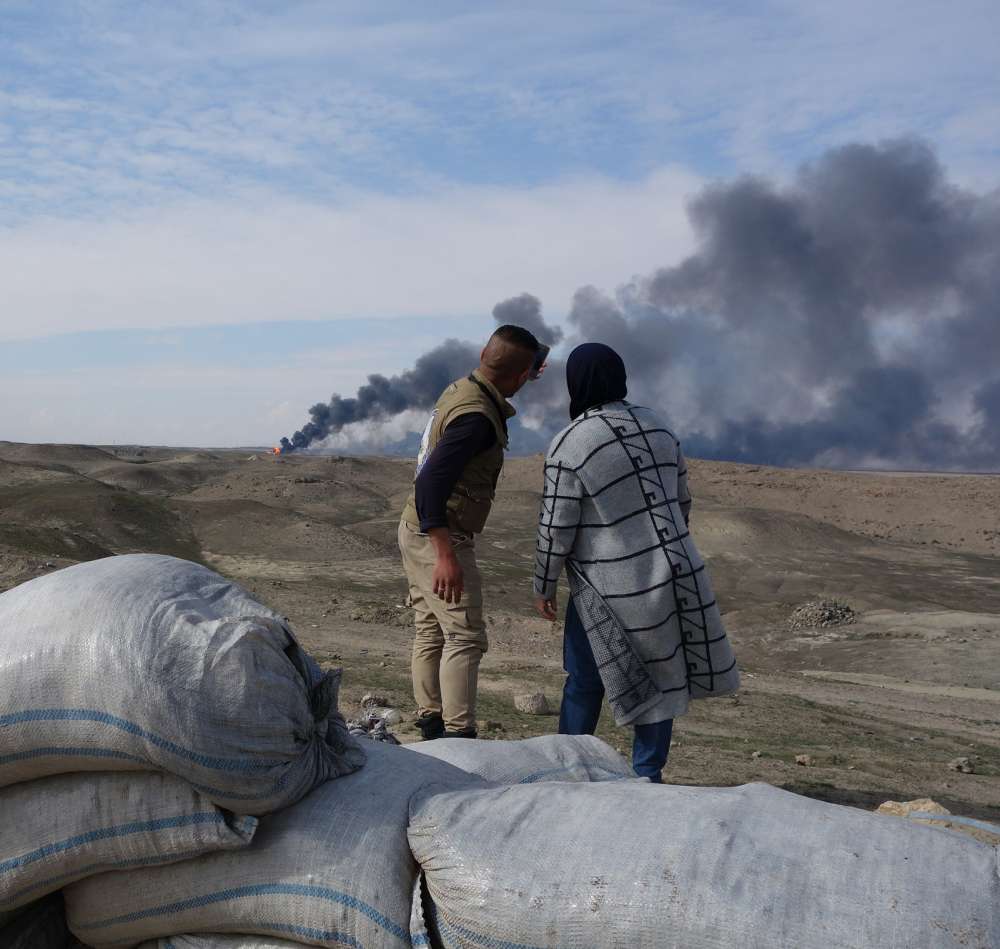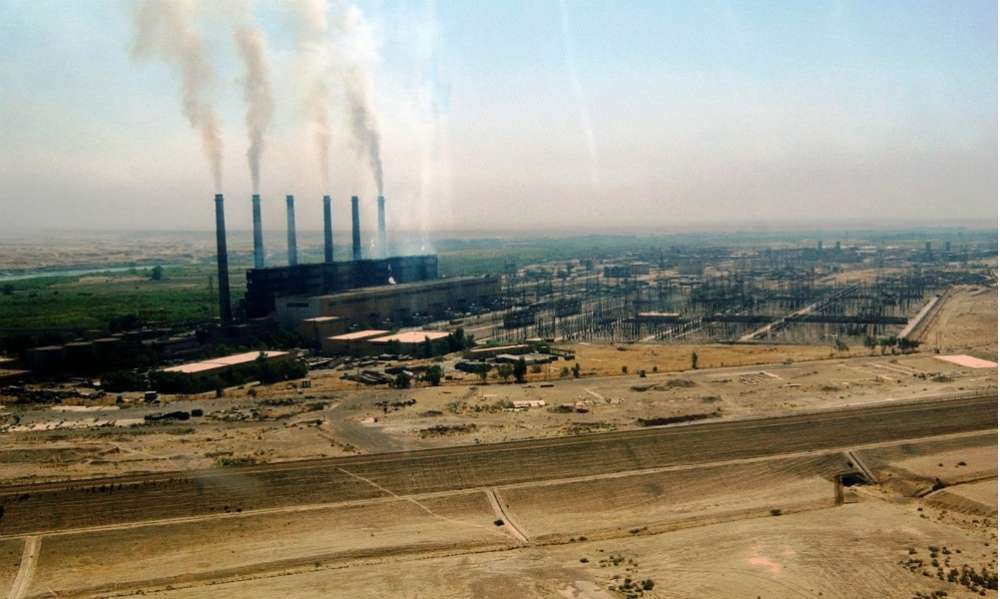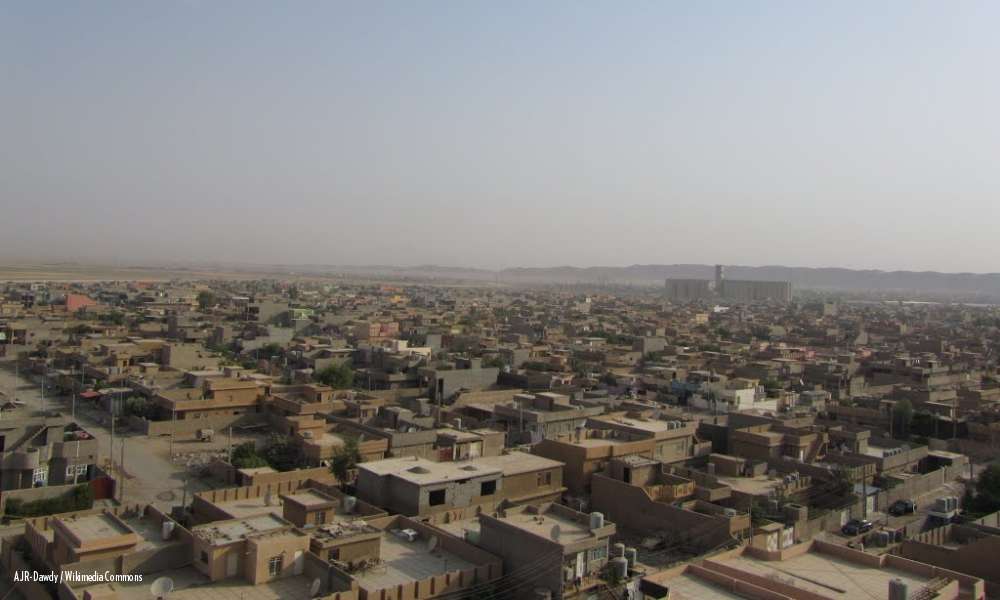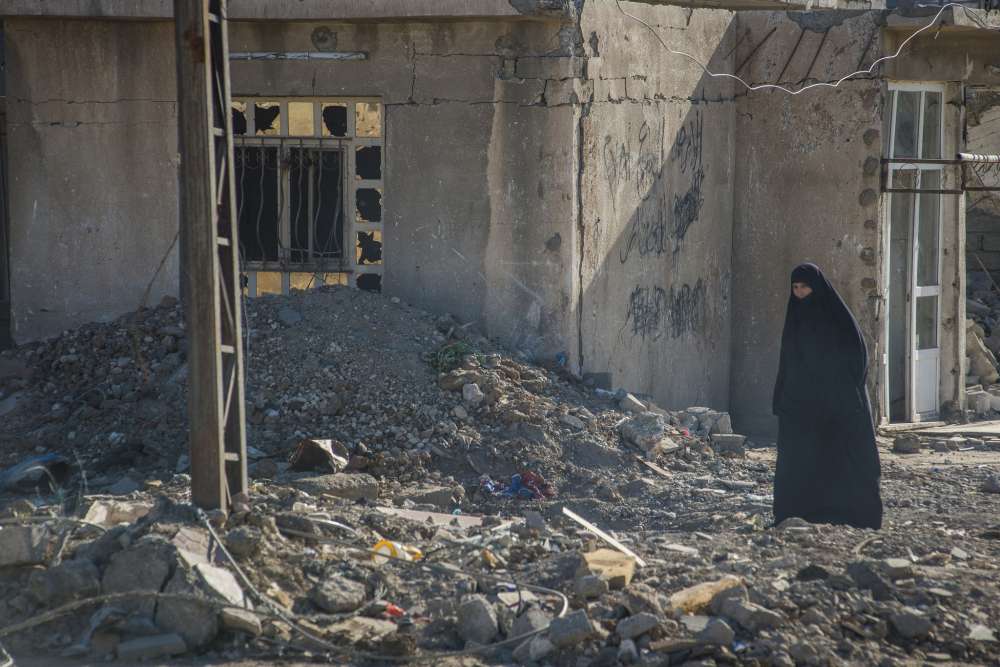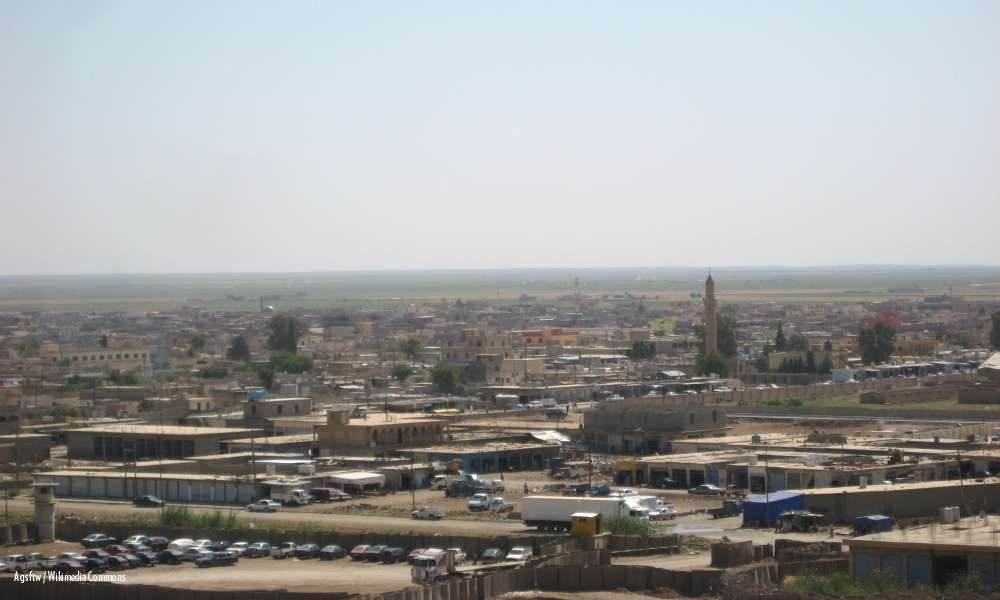Iraq after ISIL: Shirqat District

Both Sunni and Shi’a PMF have played a large role in this Sunni Arab district on the border of Ninewa and Salah ad-Din. Reports of mass forced displacement and abuses of the civilian population suggest that the road to reconciliation and recovery will be long, even after the eastern bank is retaken from ISIL.
This research summary is part of a larger study on local, hybrid and sub-state security forces in Iraq (LHSFs). Please see the main page for more findings, and research summaries about other field research sites.
Shirqat is a Sunni Arab district in northern Salah ad-Din that is directly across the governorate border from Qayyara district in Ninewa. As of early September 2017, ISIL still held half of Shirqat district, from the Tigris river eastward, making it one of the militant group’s last points of control. Local Sunni tribal units that are organized into PMF have fought against ISIL fighters alongside Shi’a PMF and the ISF. The Shi’a PMF have taken a step back from the ongoing fighting in Shirqat city but continue to control the main Tikrit-Erbil road that runs west of the city.
A popular belief holds that a significant segment of Shirqat’s population (clustered in a few villages) supported and collaborated with ISIL. Because of this presumption and the ongoing ISIL security threat, a large number of “ISIL families” were deported to IDP camps in the governorate, in one of the most extreme examples of forced displacement in the post-2014 period. While the long period of ISIL control and fighting to retake Shirqat has resulted in extreme shortfalls in basic humanitarian needs, the militants’ swift retreat to the eastern part of the district left about 90 percent of the buildings in the liberated, western part intact.
Background and ISIL Takeover
Shirqat district is the last point in Salah ad-Din on the main road that runs from Tikrit, north into Ninewa, and on to either Erbil or Mosul. Like Qayyara district on the other side of the border, Shirqat is a primarily agricultural and heavily tribal Sunni Arab district. The majority of the population hails from the Jibbour tribe (between 85 and 90 percent), and the remaining residents are from the Jumayli, Lughaybi, Qaysi, and Luhayb tribes. Prior to ISIL’s takeover, the total estimated population of 210,000 residents was fairly evenly distributed across 74 large villages, with a larger concentration in Shirqat city. At the time of writing and post-ISIL, approximately 140,000 people were estimated to be in Shirqat city and the surrounding areas; this figure included IDPs from the district’s eastern parts and the nearby Hawija district of Kirkuk governorate, both of which were still under ISIL control.
Key Facts: Shirqat
Pre-ISIL Population: 210, 000
Ethnic Composition: Sunni Arabs
Date Taken by ISIL: June 10-11, 2014
Date Reclaimed: Sept 23, 2016 (west bank), by ISF, local police, local Sunni PMF
Current Control: Shirqat city split between ISIL (east bank) and ISF/Sunni PMF; Shi’a PMF control Highway 1
LHSFs Present: League of the Righteous, Badr Organization; Sunni tribal PMF (under Shi’a PMF control)
Key Issues:
- Strong presence of local Sunni tribal forces (under PMF) with allegations of abuse, including abductions, theft, and trafficking
- ISIL presence in the eastern district
- Forced displacement of ISIL families

On June 10, 2014, ISIL took control of Shirqat and caused the immediate displacement of roughly 90,000 of the estimated 210,000 residents. According to the mayor of Shirqat, people with the means to do so fled the district. An estimated 50 percent of this group went to Iraqi Kurdistan, and the rest fled to Kirkuk (20 percent), Baghdad (15 percent), Samarra and other provinces in the south, or abroad to Jordan and Turkey. Residents with a lower socio-economic status headed to the district’s western part, called Jazeera, which was beyond ISIL’s reach at the time. They were also among the first returnees after liberation because the area later became an active war zone.2
An estimated 120,000 people have stayed on the eastern bank (or “left bank,” in local parlance) of Shirqat city, which is under ISIL control. Many locals either could not afford to flee or were forcibly prevented from doing so by ISIL. Locals reported that those who attempted to escape were subject to brutal punishment, including public execution.3 In addition, pro-government forces did not initially contest ISIL control in Shirqat city. As a result, a number of IDPs from Baiji, Tikrit, Kirkuk, and other areas fled to Shirqat city because, even if it was under ISIL control, the area was free of fighting. The city was also easily accessible because it is a connection point between Mosul and areas in Salah ad-Din and Kirkuk.
Although there was no active conflict during more than two years of ISIL occupation, conditions were still difficult. Food supplies, oil, and critical medicines ran low as the occupation continued due to blockades on trade with other areas. In general, ISIL did not destroy major infrastructure in Shirqat, but it did bomb homes that belonged to members of the security forces, especially early on in the occupation. ISIL executed many individuals in different areas of Shirqat, accusing them of cooperating with the security forces. The group also arrested many others, whose fates still remain unknown, and executed people whom they accused of fleeing the land of the Caliphate or not swearing allegiance to ISIL.
According to locals, a significant part of the population welcomed ISIL at the beginning because they thought the militants would bring a positive change to Sunni areas. Locals report that residents who sided with ISIL helped the group to enforce population controls and reported on people attempting to escape. However, as areas were liberated, the populations affiliated with ISIL would suffer some of the worst instances of forced displacement and rights deprivations in the liberated areas, as will be discussed shortly.
The Recapture of Shirqat and Ongoing Security Dynamics
The western bank of Shirqat city was liberated on September 23, 2016, in a joint operation by the Ninewa Operation Command and Salah ad-Din Operation Command. Local tribal forces from Shirqat (the so-called 51st Brigade) also played a prominent role. As most ISIL forces retreated to the east bank, they offered relatively little resistance and left behind only small units to slow the advance of pro-government forces. At the time of writing, much of Shirqat district west of the Tigris was jointly controlled: primarily by the Shirqat police and, secondarily, by the Iraqi Army (60th Brigade) and the 51st Brigade of the tribal hashd. Although the campaign to retake the eastern part of the district was launched on November 29, 2016, it was later halted (potentially because of a desire to focus on other ISIL-held areas, although this motivation could not be confirmed with ISF spokespersons). As a result, the eastern part of Shirqat district remained under ISIL control at the time of writing,4 and the overall security situation remained volatile, with occasional mortar, drone, and sniper attacks in Shirqat city and in the district’s west (Jazeera area) and south (Khanouka area).
Although Iraqi forces (with tribal PMF) hold western Shirqat city and Shi’a PMF hold the main highway, the areas between these locations and along the border with Qayyara are rural and under-populated. Iraqi forces have not cleared or re-assumed full control over all the small villages in these areas, and there are still pockets of resistance. During field research between December 2016 and February 2017, tribal forces interviewed said they were actively engaged in clearing small villages. Up to the time of writing, there were still reports of counter-attacks and insecurity emanating from these areas (as well as from the east bank of Shirqat city), suggesting that not all areas of Shirqat are firmly held.
Although an important transit point, Shirqat itself is a small and relatively under-populated district. It has not been a priority for Iraqi forces, which have focused on liberating major urban areas or attacking larger ISIL strongholds. As a result, the PMF – both southern Shi’a forces and local Sunni tribal ones – have played a much larger role in Shirqat than they have in most other areas.
After the recapture of Tikrit in April 2015 and Baiji by October 2015, Iraqi forces took control of Highway 1, a main road that runs north through Shirqat. However, while Iraqi forces were nominally in control, Shi’a PMF played a significant role in retaking the highway and have remained more or less in de facto control since then. The stretch of highway from Baiji to Shirqat is dominated by the League of the Righteous, according to local sources, although Badr fighters are also present. They man most of the checkpoints and in theory cooperate with Iraqi forces; however, they are known to follow their own orders and leaders rather than those of the local authorities or Iraqi forces. Local analysts said that in late summer 2017, US forces began constructing a base on Highway 1 between Baiji and Shirqat, an area that is predominantly under Shi’a PMF control. This act would imply some level of at least tacit cooperation between US forces and the Shi’a PMF in the area.
The PMF are in control of a major transit route that lies at the entrance to Salah ad-Din and connects it with operations and commerce routes in Mosul and Erbil; this strategic position gives them significant sway in Shirqat. They also control most of the checkpoints in and out of the Shirqat city area. As a result, even though the Shi’a PMF are not holding Shirqat city or other populated areas, they have free movement and easy access. PMF forces periodically conduct what they frame locally as “inspection tours” in certain areas of the district, which involve “checking the performance” of security units, surveying the number of suspects who have been investigated and detained on security allegations, and demanding to know the outcomes of these allegations. Locals said these tours allow the PMF to retain influence and keep a grip on security matters in Shirqat, even in areas where they are not stationed. The Shi’a PMF have also directly detained individuals they suspect of ISIL affiliation, either after vetting processes at checkpoints or during inspection tours. The PMF have at least three detention facilities in Salah ad-Din, including one in Hamra, where local sources report that at least 20 Shirqat residents are being detained.
Inside Shirqat city and many smaller villages, Sunni tribal PMF have played a dominant role. The most prominent of these forces is the 51st Brigade, which draws predominantly from local tribes from Shirqat and, to a lesser extent, from tribes from nearby Baiji district (mostly the J’bouri tribe in both areas).5 The 51st Brigade has played a significant role in operations in Shirqat city — at least optically, if not militarily. It was the first force to enter Shirqat district, although it was supported by ISF forces who, analysts say, did the bulk of the fighting. The unit that is currently stationed in Shirqat city has 360 fighters, according to the mayor.
The 51st Brigade, which is also known as the Liwa Salah ad-Din, falls under the command of Yassin al‑J’bouri, the son of a prominent political stakeholder in Salah ad-Din, Mashan al‑J’bouri.6 This latter has strong ties with central PMF leaders in Baghdad, which is why the 51st Brigade has always had the strong backing and support of Shi’a PMF forces in the area. One local researcher argued they have more support than many Iraqi Army units. Several analysts interviewed said that PMF support for the 51st Brigade plays into a larger rivalry with the Governor of Salah ad-Din, Ahmed Abdullah al‑J’bouri, and efforts to oust him.
This PMF support gives the 51st Brigade more resources and latitude for activities in areas across Salah ad-Din, not just in Shirqat. It has taken part in operations across Salah ad-Din, while other parts of the brigade (of unknown force numbers) are deployed elsewhere or reside in other areas between operations. The brigade has also been present in holding operations following the retaking of Tikrit, parts of Baiji, and other areas.
There have been significant allegations of misconduct against the 51st Brigade, including looting, robbery, abductions, and revenge killings. These allegations have followed the force wherever it has engaged: not only in Shirqat, but also in Baiji and Tikrit. The most prominent of these allegations was that they were largely to blame for the looting of Tikrit in the aftermath of liberation (although the Shi’a PMF forces they worked with were publicly blamed for the looting and may have participated in some form). In addition, although the 51st Brigade has been involved in the fight against ISIL, they have been accused by both the media and many of the sources interviewed of providing support to ISIL fighters by smuggling oil and other goods and by allowing fighters to transit through the areas the brigade controls. For example, one local researcher interviewed said that most locals assume there is a tacit or secret agreement between the 51st Brigade and the militant group due to the continuous flow of ISIL supporters across government-controlled Shirqat between Hawija and Mosul. Some of the 51st Brigade are former ISIL fighters who turned against the group, according to local reports and the mayor. Notwithstanding these reports, community members have generally welcomed the tribal hashd. “Anyone who replaces ISIL is better for the locals,” emphasized the mayor.
The 51st Brigade has a great deal of autonomy due to its force numbers, fighting capabilities, and Yassin al‑J’bouri’s strong links with Shi’a PMF. Like all Sunni PMFs in the governorate, the brigade falls under the official PMF umbrella. Although this structure should create a line of control and authority to the Iraqi government (i.e., the source of salaries), interviews with tribal forces and officials across Salah ad-Din suggest that in practice, PMF salary distribution and the regularity of full payment depend on affiliation with one of the larger Shi’a PMF. This circumstance gives the Shi’a PMF a degree of leverage over local Sunni PMF in the areas where they operate. However, affiliation with a Shi’a PMF can be both an asset and a burden. Analysts said that Yassin al‑J’bouri’s forces were able to loot Tikrit and engage in other illegal acts in part because they were protected by the much larger and uncontrollable Shi’a PMF in the governorate. However, this relationship also means that the 51st Brigade sometimes acts at the behest of the Shi’a PMF. For example, local officials in Shirqat said the 51st Brigade periodically conducts additional inspection tours and house searches on behalf of the Shi’a PMF and reports the information back to them.
While Yassin al‑J’bouri’s 51st Brigade is the most active (and notorious) force in and around Shirqat, other tribal forces are also present. However, their degree of engagement fluctuates and is difficult to confirm. The Knights of Jibbour (a group that includes Jibbouri tribesmen from Ninewa and Salah ad-Din and that is mostly engaged in Qayyara) have reportedly been active in Shirqat periodically, as have other Ninewa tribal force commanders. Researchers interviewed one tribal commander who had engaged in frontline clearing operations alongside, and even in advance of, the ISF in small Shirqat villages on the border with Qayyara, his home area. His forces were among the first in Ninewa to be established under the Tribal Mobilization Force (TMF), which is a US-supported initiative to mobilize and organize tribal fighters in Ninewa and Anbar. He later stopped working with the TMF because, he said, they did not allow him enough fighters and provisions. Coalition authorities said he left the TMF because his forces tortured ISIL members in revenge for abuses against their families.
At the time this tribal commander was interviewed, he still appeared to be registered under the PMF umbrella; 300 of his 600 forces were registered with the Iraqi government and receiving a salary. However, while most Sunni tribal PMF outside the TMF program appeared to affiliate with, or attach to, the Shi’a PMF (as does al‑J’bouri’s 51st Brigade and most others in Salah ad-Din), the interviewed tribal leader said he had refused to work with these forces; “al-hashd al-sha’abi [the Shi’a PMF] are very destructive. When they enter a village, they don’t hesitate to use rockets. They have caused a lot of damage and civilian harm wherever they go. For that reason, I don’t want to be affiliated with them.” Instead, by his account, he was taking orders directly from the ISF. He said that he led clearing operations on the ISF’s behalf and could even call in airstrikes on particular locations. People who had worked with Coalition operations confirmed that this tribal leader’s account was feasible because he has a reputation for being able to act and fight autonomously.
Forced Displacement and Lack of Return
Forced displacement and lack of return have been major issues in Shirqat. There are reports that families who are accused of collaboration with ISIL have been expelled or punished without due process.7 Although Shirqat is a tribal area, its judicial matters related to ISIL affiliation are almost exclusively handled by state structures. The Shirqat police has detained many suspected ISIL affiliates; however, interviewees claimed that suspects had been released following judicial review, which takes about two months when the legal complaints proved baseless.
There have also been serious reports attesting to high levels of forced displacement among so-called ISIL families, including women, children, and the elderly. Beginning in January 2017, Salah ad-Din Operation Command started to move ISIL families to the Shahama IDP camp, north of Tikrit.8 Interviews confirmed that this move followed a decision by the Salah ad-Din Provincial Council in August 2016.9 The exact date of the decision is not clear; however, it was followed by an escalation in forced displacement, with so-called ISIL families ordered to leave.10 Their displacement was not voluntary; Human Rights Watch (HRW) reported that PMF, both Shi’a and local Sunni tribal forces, came to ISIL families’ houses and loaded them onto trucks bound for the Shahama camp.11 According to a local researcher, an estimated 286 individuals belonging to approximately 110 ISIL families were taken to the Shahama camp. Reportedly, 145 of them are from Shirqat (on March 5, HRW reported that at least 125 families from Salah ad-Din governorate had been forced into the camp).12 Although the families are housed in an IDP camp, HRW described their conditions as closer to detention and reported that these so-called ISIL families were kept separate from the rest of the camp and were not allowed to leave or have access to mobile phones.13
The forced displacement of these families has been controversial, to say the least. While many locals broadly support the measure, the forced displacement of these families has led to a degree of public outcry in national and international circles. Many of the strongest objections have come from the humanitarian organizations that maintain the IDP facilities where “ISIL families” are housed, which have effectively become de facto detention centers for the forcibly displaced. An Iraqi Supreme Court decision in March 2017 found that the council’s decree was unlawful and that provincial councils are not allowed to authorize the displacement of residents and confiscation of their possessions.14 Reports suggest that the detained families have been released but have not returned to Shirqat, fearing further persecution. As of the time of writing, the presumed “ISIL families” displaced from Salah ad-Din were de facto barred from returning. Locally in Shirqat, the District Council issued an updated decree on July 2, 2017, that ordered all checkpoints to prevent any suspected ISIL family member from entering Shirqat.
Related to the forced displacement of ISIL families, suspicions of ISIL involvement have created obstacles to return for some residents. The mayor of Shirqat spoke of an (unconfirmed) instance in which the PMF took a number of IDPs who had arrived in Shirqat city to an unknown location; later, corpses were found in the west of the district. Given the ongoing ISIL presence in the eastern half of Shirqat and local authorities’ fear that many citizens are still involved with and supporting ISIL, there are tight security checks on all residents who try to return to the district. Returnees are vetted by a committee composed of representatives from the National Security Service, the Intelligence Service, the local police, PMF (51st Brigade), and the Iraqi Army. The Shi’a PMF also sometimes perform checks at checkpoints and inside the district through their periodic inspection tours. A single list of wanted names is available at all checkpoints. A representative of the police added that returns are often not approved because the information available on IDPs is not sufficient to meet vetting standards.15
Overall, levels of return have been moderate. Shortly after the liberation of Shirqat city and the western part of the district on September 26, 2016, all IDPs were allowed to return. For people who are not accused of ISIL affiliation, return to liberated areas has been orderly; an official from the Shirqat Department of Migration noted very few issues with the local PMF in that regard. However, about 40 percent of the population remains outside the district according to local tracking by the Department of Migration, and fresh displacement continued as of the time of writing (albeit in small numbers) due to the continuous deterioration of the security situation. According to the same official, the reasons for residents’ lack of return vary and include continued ISIL control of the eastern district, continued insecurity, difficulties with integration into new host communities, fears of being targeted by local authorities for arrest, inter-tribal issues, and a lack of basic services. Additionally, according to the same source, many people have settled in Kurdistan, which is where the majority of the IDPs fled.
According to a local official, the western part of the district has seen little destruction because ISIL retreated instead of putting up a fight. Local funds and international support, notably from the UNDP, have financed the reconstruction of the mayor’s office and police office and repairs to electrical networks and schools. The water system was not damaged; water is available 22 hours a day. Schools are open, and education is ongoing. The hospital is also operational, and some repairs were financed by the Salah ad-Din health directorate. At the time of research, all government offices were open, except for the land registry (all land property documents were stolen). The markets are open, but the banks are not yet operational.
References
1 Field research was conducted by Amin al-Qaisi. Erica Gaston and András Derzsi-Horváth provided additional reporting and analysis, and Frauke Maas contributed supporting research.
2 Today, there are no residents in the island areas because it became a military zone that is subject to almost daily, ongoing clashes between pro-government forces and ISIL.
3 Despite the threat of violence and difficulties in escaping, small waves of displacement have continued throughout ISIL’s occupation due to a lack of services and livelihood needs.
4 Institute for the Study of War, Iraq Control of Terrain Map June 16, 2017, goo.gl/nwkTpP.
5 The vast majority of the tribal forces in Shirqat are from local tribes. Between 75 and 80 percent, roughly, draw from local tribes, predominantly the J’bouris. According to the mayor, some members of the Shirqat tribal PMFs also draw from the Qaiseen and Akidat tribes from Baiji and Duleim. The same source reported that some of them are former ISIL fighters who changed sides and joined the brigade to protect their families. This brigade has received regular training, together with the Salah ad-Din Operation at Camp Speicher. Local forces said that it also receives ongoing training at military camps in the Tikrit area.
6 Nour Samaha, “Iraq’s Good Sunni,” Foreign Policy, 16 November 2016, http://foreignpolicy.com/2016/11/16/iraqs-good-sunni/.
7 Iraq Protection Cluster, Salah Al Din Returnee Profile – February 2017. (Global Protection Cluster, 2017), 2, reliefweb.int/sites/reliefweb.int/files/resources/Returnees%20Profile_Salah_al-Din_Feb2017_30032017.pdf.
8 Human Rights Watch, Iraq: Displacement, Detention of Suspected ‘ISIS Families’ (New York: Human Rights Watch, 2016), https://www.hrw.org/news/2017/03/05/iraq-displacement-detention-suspected-isis-families
9 The formal decision endorsed a recommendation by the council’s security committee for these illegal deportations, according to sources who were aware of the decision. Salah ad-Din Provincial Council Decision 3889 (September 6, 2016). [The council held its meeting on August 30, but the decision is dated September 6.]
10 Most reports suggest they were ordered to leave Salah ad-Din entirely, not just from Shirqat. However, in a seeming contradiction of this order, most were taken to the Shahama camp, which is inside Salah ad-Din.
11 HRW, “Iraq: Displacement.”
12 Ibid.
13 Ibid.
14 Decision of the Federal Supreme Court on March 7, 2017 (2016/Federal/86).
15 Interview with a Salah al-Din police representative.

